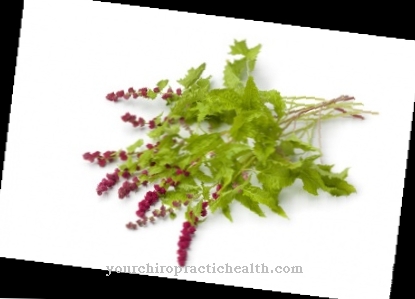The botanical name of the Real celery reads Apium graveolens and it belongs to the genus celery (Apium) and to the umbelliferae family (Apiaceae). It is used in the kitchen as a vegetable.
What you should know about real celery

Celery is not only available in the cultivated form, but also in the wild form. The characteristics of the different forms can differ greatly from one another, whereby the wild form can reach a height of up to one meter. The minimum height is thirty centimeters.
The real celery is an annual plant. It is herbaceous and is characterized by a branched and spindle-shaped root that lignifies in the second year. The stalks of the celery stand upright and are also branched. They form angular notches. The leaves are smooth and glossy and simply pinnate. They are also colored dark green. The inflorescences of the real celery are double-gold. They can be short-stalked and twelve-pointed. They have no umbel envelope. The flowers are hermaphroditic.
The essential oils - especially the phthalides they contain - are responsible for the typical celery flavor. The exact origin of celery is not known, although it was probably first cultivated in the Mediterranean region. As a cosmopolitan, however, the wild form can be found all over the world. Natural locations are moist and swampy soils that are usually salty. In Central Europe, real celery in its wild form is only found in salt areas. This form of celery has almost died out in the German federal states.
Different forms of celery include celeriac, white celery, and cut celery. In its shape, celery is most similar to the wild form. The leaves are reminiscent of parsley and the tuber is not very pronounced. Wild celery was already used as a medicinal plant in ancient times. Both in Egypt and in Greece the usage has been handed down in writing.
Celery is harvested between July and October. The main season in Germany is during this period. The celery, which can be found in supermarkets in autumn and winter, comes to Germany almost exclusively from Israel. Celery has a very special taste that is unique and strongly aromatic.
Importance to health
Celery is also used as a medicinal plant in folk medicine. It is said to have an anti-fever, diuretic and blood-purifying effect. In addition, it should be digestive and expectorant, wind driving and tonic.
The fruits, the leaves and the roots are used, whereby the components are used both internally and externally. The medicinally and pharmaceutically relevant ingredients of real celery are essential oils, coumarin, sugar, resin and various vitamins. It is used, among other things, for arthritis, cough, flatulence and urinary tract diseases. But celery is also interesting from a nutritional point of view. The essential oils are said to have an antihypertensive effect. In addition, celery inhibits the growth of unhealthy bacteria and fungi in the throat and mouth area as well as in the stomach.
The vitamins it contains make celery in general very healthy. Potassium stimulates the metabolism and circulation and is invigorating. It also promotes the formation of stomach acid. On the other hand, people with kidney problems should rather enjoy celery in small quantities, as it irritates the kidneys and can lead to discomfort.
Ingredients & nutritional values
| Nutritional information | Amount per 100 gram |
| Calories 16 | Fat content 0.2 g |
| cholesterol 0 mg | sodium 80 mg |
| potassium 260 mg | carbohydrates 3 g |
| Fiber 1.6 g | protein 0.7 g |
Over 90% of real celery consists of water. Otherwise it is very low in calories and fat. 100 grams of food contain just 0.2 grams of fat and 21 kilocalories. But it contains 1.1 grams of minerals and 2.5 grams of fiber. The same amount of celery contains 1.2 grams of protein.
Otherwise the vegetables have a number of vitamins. Celery contains folic acid, vitamin E, and various B-class vitamins. In addition, 100 grams of vegetables contain 7 milligrams of vitamin C and 29 µg of vitamin K. Celery also has niacin equivalent, ß-carotene, retinol equivalent and pantothenic acid. Trace elements and minerals that make celery particularly healthy are potassium, sodium, calcium and magnesium. Celery also contains manganese, fluoride, chloride and phosphorus.
Intolerances & allergies
Celery is one of the foods that often cause allergies. This is problematic, among other things, because the vegetables are often contained in small quantities in soups, sauces and spice mixes. Various ready meals also often contain celery. It is therefore often difficult for those affected to avoid the allergen entirely. The only sensible thing is to study the ingredients of ready-made and canned meals. Spices should be bought individually and mixed yourself. This means that allergy sufferers are also on the safe side.
In Germany, between 30 and 40% of the population is said to suffer from a celery allergy. Pollen allergy sufferers are particularly often affected, as it can lead to a so-called cross allergy. This is particularly true of people who are allergic to mugwort and birch. In medicine, this case is called birch-mugwort-celery sydrome. Often people who cannot tolerate celery also react to fennel, carrots, aniseed or parsley.
The reason for these cross allergies are the similar chemical structures of the allergens. Typical reactions to celery are expressed as oral allergy syndromes. This means that there can be discomfort in the mouth and throat. Examples of this are swellings, blisters or itching in the mouth. Other symptoms include itchy eyes, sneezing fits, gastrointestinal problems, or hives. In severe cases, breathing problems can also arise.
Shopping & kitchen tips
When shopping for celery, attention should be paid to the freshness of the vegetables. The leaves should still be green and not have any brown spots. Celery stays crisp the longest. It can be kept in the refrigerator for up to two weeks, provided it is kept in an airtight bag.
Nevertheless, celery should be consumed as quickly as possible, otherwise the vitamins are quickly lost. For example, celeriac can be kept in a dark, cool room. It should be wrapped in newspaper or stowed in a box with sand. In this case, the optimal temperature is around five degrees Celsius.Before using, celery should always be washed under running water.
Preparation tips
Depending on the type, celery can be used for a wide variety of purposes. It can be eaten raw with cream or soft cheese. But it is also eaten with dips. Celery can be boiled, stewed or braised as a vegetable. It is popular, for example, in casseroles and gratinated with cheese.
Celery is also perfect in soups. It goes well with nuts, tomatoes and various salads. Hemp and olive oil can be combined as a salad dressing. You can also use apple cider vinegar or orange juice. Celery can be processed and prepared like asparagus, and it also goes well with risotto or stews.



























